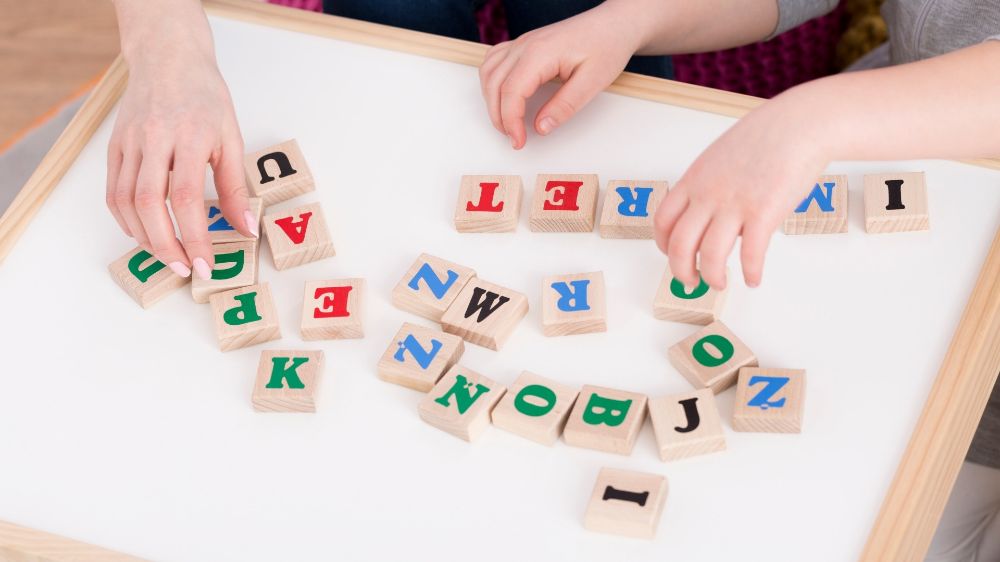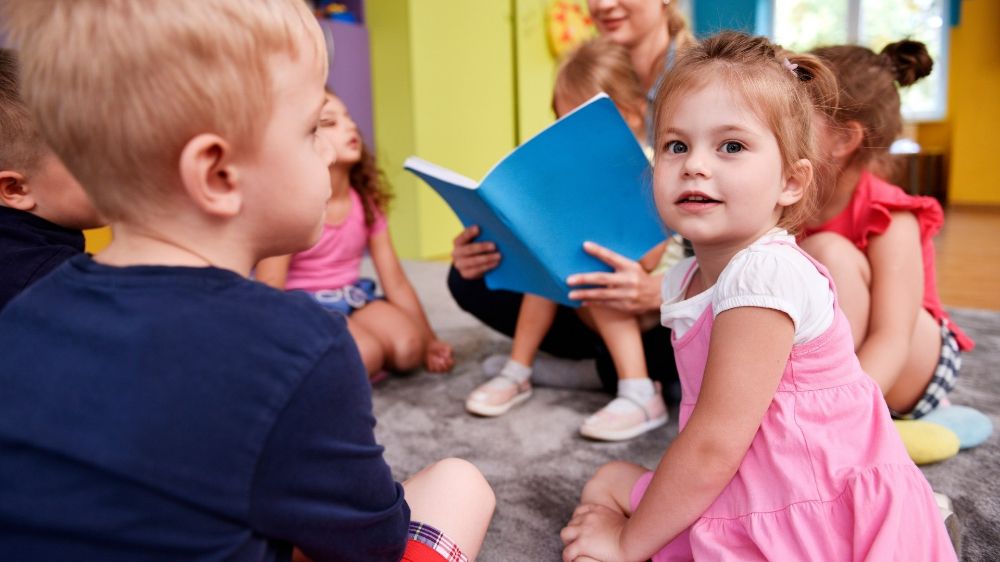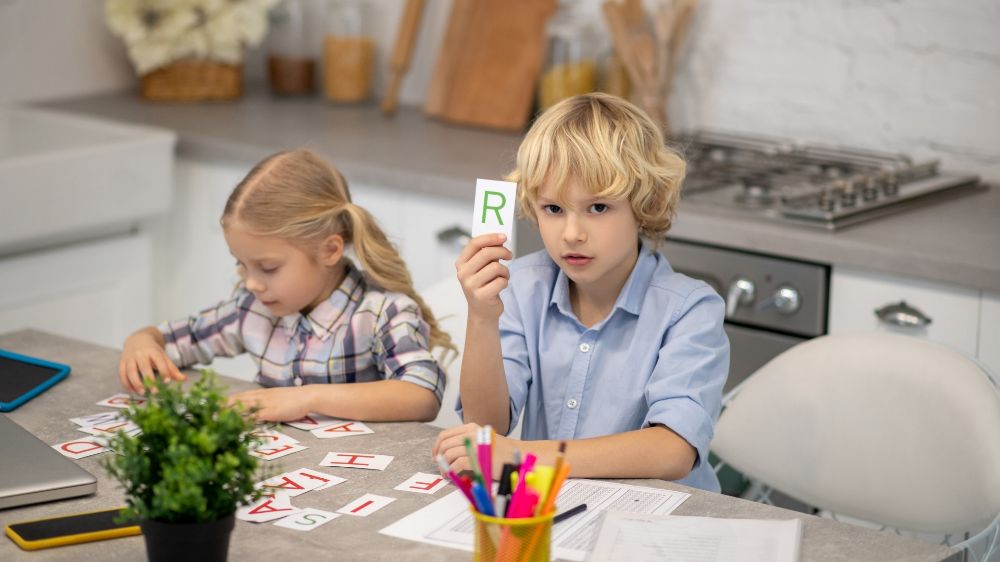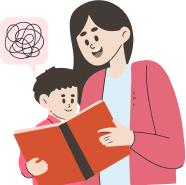Your child struggles to read new words. They see letters but cannot connect them to sounds, turning every reading attempt into a frustrating challenge.
Phonological awareness games offer a proven solution. Backed by literacy experts, these activities strengthen sound recognition, rhyming, and blending skills while keeping learning playful. Kids engage actively and build essential reading skills without even realizing they are developing these skills.
This blog guides you through ten phonological awareness games designed to develop reading skills in a step-by-step approach. Follow the activities at home to boost your child’s confidence, fluency, and love for reading.
Key Takeaways
-
Phonological awareness games strengthen children’s ability to hear, manipulate, and recognize sounds in spoken language.
-
Interactive activities improve attention, memory, and sound-symbol connections essential for reading.
-
Combining play with structured practice helps build confidence and fosters positive attitudes toward reading.
-
Regular, guided gameplay prepares children for independent decoding, fluent reading, and long-term literacy success.
What is Phonological Awareness?

Phonological awareness means recognizing and working with sounds in spoken language. Your child learns to recognize individual sounds, syllables, and word patterns before learning to read printed text.
This skill develops in stages. First, children notice rhyming words and syllables. Then they identify beginning and ending sounds. Finally, they manipulate individual sounds within words.
Think of it as sound detective work. Your child learns to break apart words like puzzles. They discover that "cat" has three sounds: /c/ /a/ /t/.
Strong phonological awareness predicts reading success better than alphabet knowledge. Children who master these sound skills decode new words independently.
Why Phonological Awareness Games Help Kids Build Reading Skills?
Phonological awareness games turn learning into an active, hands-on experience. Children practice the key skills that form the foundation for reading while staying engaged and motivated.
According to research, children who receive phonemic awareness instruction are more likely to develop strong early reading skills compared to those who do not.
Here’s how these games strengthen early reading development:
-
Boosts Sound Recognition: Games help children notice and identify individual sounds in words. Repeated practice with varied activities makes these sound patterns familiar, which is critical for decoding new words.
-
Improves Listening and Attention: By focusing on specific sounds, rhymes, or syllables, children enhance their listening skills. This focused attention translates directly into better reading comprehension and word recognition.
-
Reinforces Phonemic Memory: Playful repetition through games strengthens memory for sound patterns, letter-sound relationships, and word structures, skills essential for fluent reading.
-
Encourages Active Learning: Unlike passive activities, games require children to respond, manipulate sounds, and make decisions. This active engagement deepens understanding and supports retention.
-
Connects Fun to Reading Success: When learning feels like play, children develop positive associations with reading. Confidence and curiosity grow alongside skill, making reading a rewarding experience.
These benefits show why structured phonological games are not just fun—they directly prepare children for reading success. Next, let’s explore ten effective games that put these skills into action.
Also Read: Understanding Phonological Awareness and Development
List of Top 10 Phonological Awareness Games for Kids

Introducing phonological awareness through games makes learning an active, playful, and memorable experience. The activities below focus on various aspects of sound awareness, including rhyming and syllables, as well as blending and decoding. Each game is designed to keep children engaged while providing them with practical experience in the skills that make reading easier.
Let’s look at some of the phonological awareness games that you can play with your kid.
1. I Spy Sound Hunt
I Spy originated in Victorian England and first appeared in written records during the late 1800s. The classic game focuses on developing sound recognition skills. Children listen for specific sounds in their environment as they develop auditory discrimination skills.
Materials Needed
- No materials required
How to Play
-
Begin with clear, distinct sounds like /m/, /b/, or /s/
-
Say "I spy something that starts with the sound /m/"
-
Allow your child time to explore the room or area.
-
Accept any correct answer like "mat," "mirror," or "mug"
-
Provide gentle hints if they struggle: "It's something we sleep on."
-
Switch roles so your child becomes the spy.
-
Gradually introduce trickier sounds like /th/ or /ch/
-
Play in different locations to expand vocabulary.
-
Celebrate correct answers with enthusiasm.
-
Keep sessions short and fun to maintain interest.
Skills Developed
- Sound identification.
- Listening concentration.
- Sound-symbol connections.
- Vocabulary expansion.
2. Rhyme Dominoes
Rhyme Dominoes offers a structured approach to teaching children rhyming patterns. Players connect words that sound similar at the end.
Materials Needed
-
Index cards or paper squares.
-
Markers or crayons.
-
Pictures of rhyming objects.
-
About 20-30 cards total.
How to Play
-
Draw or find pictures of objects that rhyme in pairs.
-
Create dominoes with one picture on each half.
-
Make cards like: cat-hat, sun-run, tree-bee
-
Deal seven cards to each player.
-
Place the remaining cards in a draw pile.
-
The first player places any domino on the table.
-
The next player must match one end with a rhyming picture.
-
If no match exists, the player draws from the pile.
-
Continue taking turns until someone uses all the cards.
-
The winner gets to choose the next rhyming family.
-
Start with simple rhymes and add complexity gradually
Skills Developed
-
Rhyme recognition
-
Pattern identification
-
Strategic thinking
3. Sound Hopscotch
Sound Hopscotch combines the ancient game of hopscotch with phonological learning. The first recorded references to hopscotch in the English-speaking world date back to the late seventeenth century, although some sources suggest that Roman soldiers used similar courses for training. This active game combines physical movement with sound practice. Children jump while saying sounds or syllables.
Materials Needed
-
Chalk for outdoor play
-
Tape for indoor squares
-
Small object for tossing
-
Space for jumping
How to Play
-
Draw traditional hopscotch squares numbered 1-10
-
Write different letters in each square instead of numbers.
-
Child tosses a small stone or beanbag onto a letter.
-
Hop to that square on one foot, avoiding the stone.
-
Pick up the stone while balancing on one foot.
-
Say the letter sound clearly: /b/ not "bee"
-
Think of three words starting with that sound.
-
Hop back to start, still avoiding the stone square.
-
Take turns with other players or family members.
-
Make it harder by asking for rhyming words.
-
Create theme variations like animals or colors
Skills Developed
-
Letter-sound correspondence
-
Gross motor coordination
-
Sound production practice
-
Multi-sensory learning
4. Alliteration Adventure
Alliteration games focus on words with repeated beginning sounds. Children practice identifying and isolating initial sounds while improving phonemic awareness and pronunciation skills. Tongue twisters and word pairs make this activity fun and engaging.
Materials Needed
-
No materials required
-
Optional: tongue twister cards or word lists for inspiration
How to Play
-
Start with simple pairs of words that share the same first sound, like “bee, ball”
-
Say the words aloud and ask your child to repeat them, emphasizing the first sound.
-
Progress to a short series of words with the same initial sound, such as “sun, sand, sock”.
-
Introduce tongue twisters for more advanced practice, such as “Peter Piper picked a peck of pickled peppers.”
-
Ask your child to repeat and identify the first sound in each word.
-
Encourage role reversal so your child can lead the activity.
-
Gradually add more challenging sounds or longer phrases.
-
Celebrate correct answers and keep sessions short and playful.
Skills Developed
-
Initial sound recognition.
-
Auditory discrimination.
-
Pronunciation and memory.
5. Syllable Relay Race
The Syllable Relay Race transforms counting practice into an energetic team-building activity. Children race while clapping syllable beats.
Materials Needed
-
List of multi-syllable words
-
Space for running
-
Timer or stopwatch
-
Small prizes or stickers
How to Play
-
Divide children into two equal teams at the starting line.
-
Call out a multi-syllable word like "banana" or "elephant"
-
The first child from each team claps out the syllables.
-
After clapping, they run forward one step per syllable.
-
"Ba-na-na" means three running steps forward.
-
Team members count syllables aloud together for support.
-
The child runs back to tag the next teammate.
-
Continue until all team members have participated.
-
Award points for correct syllable counting and completion
-
Use words of varying difficulty based on age group.
-
Make it educational by discussing the meanings of the words afterward.
Skills Developed
-
Syllable counting
-
Rhythm recognition
-
Auditory processing
-
Team cooperation
6. Mystery Bag Phoneme Detective
Mystery Bag Phoneme Detective combines tactile exploration with sound identification. Children guess objects by feeling while focusing on beginning sounds.
Materials Needed
-
Fabric bag or pillowcase
-
8-10 small objects
-
Objects with clear beginning sounds.
-
List of target sounds
How to Play
-
Fill the bag with objects having distinct beginning sounds.
-
Include items like a ball, a cup, a shell, and a toy car.
-
Child reaches into the bag without looking.
-
They feel one object carefully with their hands.
-
Before guessing the object, they predict the beginning sound.
-
Ask "What sound do you think this starts with?"
-
Child makes their sound guess first: /b/, /c/, /sh/
-
Then they guess the actual object name.
-
Pull out the object to confirm both guesses.
-
Discuss why the sound match was correct or incorrect.
-
Rotate objects regularly to maintain challenge and interest
Skills Developed
-
Tactile discrimination
-
Sound isolation
-
Critical thinking
-
Sensory integration
7. Silly Songs and Rhymes
Musical activities use familiar tunes with new rhyming words. Children create verses while practicing sound patterns.
Materials Needed
-
Familiar song melodies
-
List of rhyming word families
-
Optional musical instruments
-
Recording device for playback
How to Play
-
Choose familiar melodies like "Twinkle Twinkle Little Star"
-
Select a word family like "-at" words.
-
Replace original lyrics with rhyming words from that family.
-
Sing "Twinkle twinkle little cat, sitting on a yellow hat"
-
Continue with "In the corner with a bat, looking very round and fat"
-
Take turns creating new verses with family members.
-
Record your silly songs for playback and laughter.
-
Try different melodies with the same word family.
-
Challenge children to suggest new rhyming words.
-
Make up actions or dances to accompany the songs.
-
Create themed songs about animals, food, or colors
Skills Developed
-
Rhyme creation
-
Musical rhythm
-
Creative expression
-
Memory reinforcement
Also Read: How to Improve Your Child’s Reading Skills
8. Telephone Game
The Telephone Game evolved naturally in different cultures over time. Its modern form as a parlor game became especially popular in the mid-1900s. This listening game focuses on careful sound discrimination. By playing this game, children can practice accurately hearing and repeating sound sequences.
Materials Needed
-
Group of 4-6 children
-
Comfortable seating arrangement
-
List of sound patterns
-
Quiet environment
How to Play
-
Arrange 4-6 children in a comfortable circle.
-
Start with simple sound patterns like "ba-da-ga"
-
Whisper the pattern clearly to the first child.
-
Each child whispers what they heard to the next person.
-
Encourage careful listening without rushing.
-
The last child announces the pattern they received
-
Compare the final result to the original pattern.
-
Discuss how sounds changed along the way.
-
Try single sounds first, then build to more extended sequences.
-
Use real words once children master sound patterns.
-
Make it silly by using funny sound combinations deliberately
Skills Developed
-
Auditory memory
-
Sound sequence recognition
-
Careful listening
-
Communication skills
9. Onset and Rime Play
This advanced game teaches word family patterns. Children manipulate beginning sounds while maintaining consistent ending patterns.
Materials Needed
-
Word family cards
-
Magnetic letters or tiles
-
Whiteboard or paper
-
Common rhyme patterns list
How to Play
-
Begin with common rime patterns like "-at," "-an," "-op"
-
Write the rime pattern on paper or a whiteboard.
-
Show your child how to add different beginning sounds.
-
Start with "-at" and add "c" to make "cat"
-
Continue adding "b," "h," "r," "m" for more words.
-
Have your child suggest new beginning sounds to try.
-
Write each new word as you create it together.
-
Read all the words in the family aloud.
-
Challenge them to think of silly or unusual combinations.
-
Try the same process with different rhyme families.
-
Connect this to actual reading by finding these words in books
Skills Developed
-
Word family recognition
-
Sound blending
-
Spelling patterns
-
Reading preparation
10. Syllable Splash / Counting Claps
Kids splash through water while counting syllables, making each word’s parts easy to recognize. The activity keeps them engaged and reinforces sound segmentation naturally.
Materials Needed
-
Large water container or kiddie pool
-
Floating toys or objects
-
Towels for cleanup
-
List of various-length words
How to Play
-
Set up a large water container or a small kiddie pool.
-
Place floating toys or objects in the water.
-
Start with simple one-syllable words like "cat" or "dog"
-
Say each word clearly and slowly.
-
Child splashes the water once for each syllable they hear.
-
Count the splashes together out loud.
-
Progress to two-syllable words like "happy" or "water"
-
Try challenging three-syllable words like "elephant" or "bicycle"
-
Make it competitive by timing correct responses.
Skills Developed
-
Syllable awareness
-
Counting coordination
-
Sensory engagement
-
Joyful learning associations
Also Read: Engaging Reading Fluency Games for Students
How FunFox Uses Phonological Awareness Games to Build Reading Skills?

At FunFox, phonological awareness is the foundation of every Readers Club session. Our teachers guide children through hands-on games and structured activities that make sound recognition, rhyming, and syllable counting both fun and meaningful.
-
Small Group Instruction: Teachers work with a small group of children at a time, providing personalized guidance during each game.
-
Skill-Focused Games: Every activity targets a specific phonological skill, from identifying sounds to blending and segmenting words.
-
Step-by-Step Progression: Games begin simple and gradually become more challenging as children gain confidence and mastery.
-
Regular Feedback: Teachers monitor performance in real time, adapting activities to each child’s pace.
-
Home Support: Parents receive easy-to-use game ideas to practice phonological skills at home, reinforcing learning beyond class.
FunFox combines structured instruction with interactive play, helping children develop strong reading foundations while building confidence and a love for learning.
Conclusion
Phonological awareness games transform reading challenges into enjoyable learning opportunities. These activities build the sound skills your child needs for reading success.
Begin with simple games that align with your child's current abilities and interests. Consistent practice through play creates lasting learning that supports future reading achievements.
Remember that every child develops at their own pace. Celebrate small victories and maintain patience as skills emerge naturally through regular gameplay.
Strong phonological awareness opens doors to confident, fluent reading. These foundational skills benefit your child throughout their entire educational journey.
Help your child discover a love for reading. Explore the FunFox Readers Club, where stories come alive and reading becomes an adventure. Book a free trial class now!
FAQ’s
1. How to make phonological awareness fun?
Incorporate songs, movement, and hands-on activities. Use games, rhymes, and playful challenges to engage children, encouraging exploration of sounds while keeping learning lively, interactive, and enjoyable.
2. How to teach a child phonological awareness?
Model listening for sounds, segment words, and practice rhymes regularly. Encourage repetition, active participation, and experimentation with syllables and letters. Reinforce skills with playful, short, and structured exercises.
3. What are the three routines to build students' phonological awareness?
Read aloud daily, emphasizing sounds, practice rhyming word games, and engage in segmenting or blending activities. Repeat consistently, gradually increasing difficulty to strengthen auditory and decoding skills.
4. What are the seven phonological awareness skills?
Recognizing rhymes, counting syllables, identifying initial sounds, isolating final sounds, blending sounds into words, segmenting words into sounds, and manipulating phonemes to create new words.
5. What are the three routines to build students' phonological awareness?
Integrate daily sound-focused reading, rhythm, and rhyme activities, and phoneme manipulation exercises. Maintain consistency and gradually increase complexity to enhance listening, decoding, and word recognition skills.















